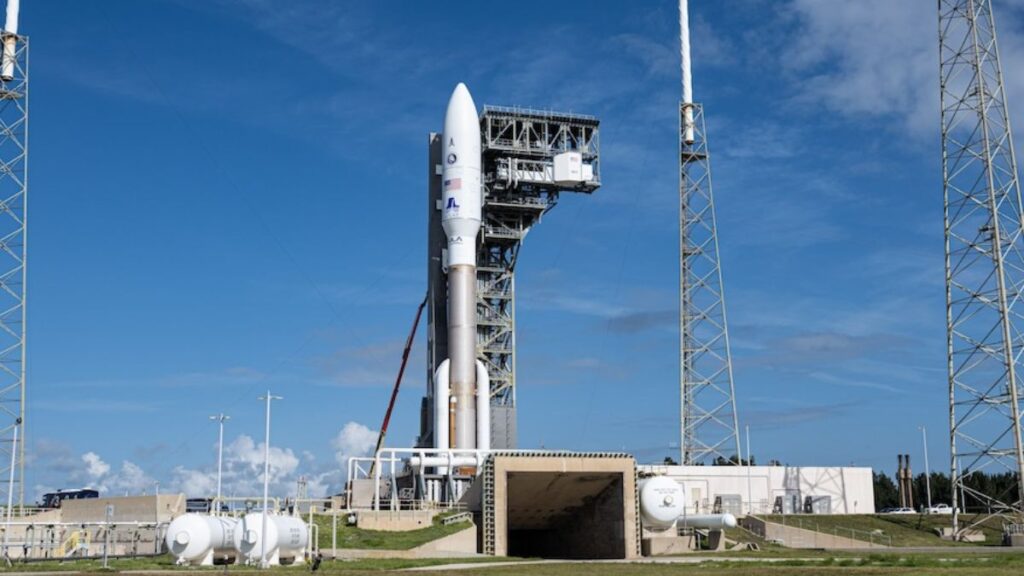
 Live Coverage: ULA launches Atlas 5 rocket on the company’s 100th national security mission
Live Coverage: ULA launches Atlas 5 rocket on the company’s 100th national security mission
United Launch Alliance marked a major milestone Tuesday with the launch of the 100th national security payload since the company was founded nearly two decades ago, as an Atlas 5 rocket blasted off from Cape Canaveral with a spy satellite for the U.S. government.
The 197-foot-tall (60-meter) launcher, emblazoned with an American flag on its nose cone, climbed off pad 41 at Cape Canaveral Space Force Station at 12:18 p.m. EDT (1618 GMT) Tuesday, arcing eastward over the Atlantic Ocean on 1.8 million pounds of thrust from its Russian-made RD-180 main engine and four strap-on solid rocket boosters.

The rocket’s hydrogen-fueled Centaur upper stage fired its Aerojet Rocketdyne RL10 engine twice to reach the intended orbit for the mission’s classified payload, a spy satellite for the U.S. National Reconnaissance Office.
The successful launch was the 91st dedicated mission for the National Reconnaissance Office by a ULA Atlas or Delta rocket, counting flights that lofted single NRO payloads and launches that carried multiple satellites owned by the NRO and other government agencies.
“This is a big day for ULA,” said Tory Bruno, ULA’s president and CEO. “This is our 100th mission for national security, and it’s also the 30th year of Atlas (launches) from Cape Canaveral.”

The launch was the 94th flight of an Atlas 5 rocket since 2002, and the 16th mission hosted by ULA so far this year. With six more launches planned through the end of the year, ULA is on track to exceed its previous annual launch record of 18 missions in 2022.
“We’re going to do 24 launches this year,” Bruno said in an interview with Spaceflight Now. “That’s a record for our company, and it’s a record for the United States.”

The NROL-108 mission launched Tuesday was the fourth flight for the U.S. government’s spy satellite fleet in less than three months. ULA launched two spy satellite missions from California and Florida in May, and SpaceX delivered a payload for the NRO’s sister agency, the National Geospatial-Intelligence Agency, on a Falcon Heavy rocket June 1.
The NROL-108 mission launched Tuesday was the fourth flight for the U.S. government’s spy satellite fleet in less than three months.

The NROL-108 mission launched Tuesday was the fourth flight for the U.S. government’s spy satellite fleet in less than three months. ULA launched a spy satellite for the National Reconnaissance Office May 18 from Space Launch Complex-3 at Vandenberg Space Force Base in California, then a SpaceX Falcon Heavy rocket took off from pad 39A at NASA’s Kennedy Space Center on June 1 with a payload for the National Geospatial-Intelligence Agency, another intelligence-gathering agency in the U.S. government’s spy satellite fleet.
A ULA Atlas 5 rocket launched another NRO mission May 25 from Cape Canaveral, followed by the NROL-108 launch Tuesday.

“We’re in a period of time where there’s a lot of launches,” Bruno said. “We’re launching about every two weeks, and that’s going to continue through the rest of the year.”
The NROL-108 mission was the 100th national security launch by ULA since the company’s formation in December 2006. The company has launched 94 Atlas 5s, five Delta 4-Heavys, and one Delta 2-7920, a two-stage light class launcher, on national security missions since 2006.
“It’s a big milestone for the company,” Bruno said. “It’s a big milestone for the nation. This is a hundred national security space missions, and that’s a lot. That’
s a lot of capability that’s been delivered on orbit to support our country.”
The NROL-108 mission was the 300th launch from Cape Canaveral to target an orbit above Earth, including launches by ULA, SpaceX, and other companies.
“It’s a big deal for the Cape,” Bruno said. “It’s a big deal for the Space Force, and it’s a big deal for the nation.”
The first launch from Cape Canaveral occurred in September 1957, when the U.S. Army attempted to orbit a satellite on a Redstone missile. That mission failed, but the U.S. successfully launched the Explorer 1 satellite from Cape Canaveral on a Jupiter-C rocket in January 1958.
The launch Tuesday was the 18th of the year from Cape Canaveral, and the 24th orbital launch attempt worldwide in July, tying a record for the most space launches in a month.
The ULA team has already begun preparations for the company’s next mission, which is scheduled for liftoff Aug. 17 from Vandenberg Space Force Base in California. That mission, designated NROL-91, will also fly on an Atlas 5 rocket.
“We’re going to launch 24 times this year, and that’s a record for the United States,” Bruno said. “We’re going to launch 14 times from Cape Canaveral, and that’s a record for the Cape. We’re going to launch 10 times from Vandenberg, and that’s a record for Vandenberg.
“We’re going to launch more Atlas rockets this year than we’ve ever done before, and we’re going to launch more Vulcan rockets than we’ve ever done before,” Bruno said, referring to ULA’s next-generation Vulcan Centaur rocket, which debuted in November with a successful test flight from Cape Canaveral.
“We’re going to launch more rockets this year than we’ve ever done before, and we’re going to do it safely and reliably, and that’s what we do,” Bruno said.
The ULA team has already begun preparations for the company’s next mission, which is scheduled for liftoff Aug. 17 from Vandenberg Space Force Base in California. That mission, designated NROL-91, will also fly on an Atlas 5 rocket.
ULA has launched 13 times so far this year, including seven Atlas 5 flights, five missions using the smaller Vulcan Centaur rocket, and one Delta 4-Heavy launch. The Delta 4-Heavy, the most powerful rocket in the U.S. fleet, is retiring this year after three final flights.
The Delta 4-Heavy’s final mission is scheduled for late November, when it will haul the classified NROL-91 payload into orbit for the NRO.
The NROL-108 mission launched Tuesday was the 16th flight of an Atlas 5 in the rocket’s “541” configuration, featuring a 13-foot-diameter (4-meter) payload fairing, four solid rocket boosters, and a single-engine Centaur upper stage.
The configuration has become the most common variant of the Atlas 5 rocket, and has proven to be a versatile workhorse for ULA, launching national security payloads, NASA science missions, and commercial satellites.
The RD-180 main engine shut off and the four strap-on boosters separated from the Atlas 5 first stage nearly four minutes into the mission. The first stage fell into the Atlantic Ocean northeast of the Bahamas, while the Centaur engine ignited to continue the journey into orbit.
The Centaur stage shut down its RL10 engine, which consumes liquid hydrogen and liquid oxygen propellants, about nine minutes after liftoff, then coasted through the orbit high above Earth where the NROL-108 satellite was headed.
The upper stage re-started its engine nearly two hours into the mission for a short firing to circularize its orbit, then deployed the NROL-108 satellite.
The NROL-108 payload is classified, and officials have not disclosed its purpose or design. Based on the size of the payload fairing, the satellite launched Tuesday is likely a large, high-value spy satellite for the NRO’s fleet of electro-optical and radar imaging spacecraft.
The NRO owns and operates the U.S. government’s fleet of spy satellites, which collect intelligence data beamed back to the ground from orbit. The agency’s spacecraft are believed to include optical and radar imagery satellites, eavesdropping stations, and data relay platforms.
The NRO’s satellites provide intelligence data to policymakers, the intelligence community, the Defense Department, and U.S. military commanders around the world.
The NROL-108 mission was the 300th launch from Cape Canaveral targeting an orbit above Earth, including launches by ULA, SpaceX, and other companies.
“It’s a big deal for the Cape, it’s a big deal for the Space Force, and it’s a big deal for the nation,” Bruno said.
The first launch from Cape Canaveral occurred in September 1957, when the U.S. Army attempted to orbit a satellite on a Redstone missile. That mission failed, but the U.S. successfully launched the Explorer 1 satellite from Cape Canaveral on a Jupiter-C rocket in January 1958.
The launch Tuesday was the 18th of the year from Cape Canaveral, and it was the 24th orbital launch attempt worldwide in July, tying a record for the most space launches in a month.
“This is a very busy year,” Bruno said.
United Launch Alliance: A History of Success
United Launch Alliance (ULA) is a renowned aerospace company with a long history of successful space missions. Founded in 2006 as a joint venture between Lockheed Martin and Boeing, ULA has established itself as a leading provider of space launch services for both government and commercial customers. With a focus on reliability, innovation, and customer satisfaction, ULA has played a crucial role in advancing the field of space exploration and national security. This article takes an in-depth look at ULA, its history, major achievements, and future endeavors.
Early Beginnings and Formation
The origins of ULA can be traced back to the early 2000s when Lockheed Martin and Boeing, two aerospace giants, recognized the need for a dedicated launch service provider. At the time, both companies were independently developing their own launch vehicles, the Atlas and Delta families of rockets, respectively.
In 2005, the two companies announced their intention to join forces and create a new entity that would combine their expertise and resources. This decision was driven by a desire to streamline the launch industry, reduce costs, and provide more efficient and reliable services to customers.
The formation of ULA was officially announced on December 2, 2006, with the company headquartered in Denver, Colorado. From the outset, ULA’s mission was clear: to provide evolutionary launch capabilities that would ensure reliable, cost-effective, and responsive space access for the nation’s most critical space missions.
The Atlas and Delta Rocket Families
ULA inherited a rich legacy of launch vehicles from its parent companies, including the Atlas and Delta rocket families. These rocket systems have played a pivotal role in U.S. space exploration and national security missions for decades.
The Atlas rocket series has its roots in the 1950s, initially developed as an intercontinental ballistic missile (ICBM) by Convair. The first successful launch of an Atlas rocket occurred in 1957, and it went on to become a key player in the Space Race, including launching missions such as Mercury-Atlas and Project Gemini. Over the years, the Atlas rocket evolved through various configurations, with ULA introducing the highly successful Atlas V in 2002.
The Delta rocket family has an equally impressive history, with its lineage dating back to the 1960s. Developed by Douglas Aircraft Company, which later became part of Boeing, the Delta rocket series has been a workhorse for U.S. space missions. The Delta II, in particular, was widely used for NASA science missions, including the launch of the Mars rovers Spirit and Opportunity. ULA introduced the more powerful Delta IV in 2002, offering heavier lift capabilities.
A Strong Track Record of Success
ULA quickly established itself as a leading launch service provider, delivering unmatched reliability and mission success. The company’s first launch occurred on December 14, 2006, just 12 days after its formation, with an Atlas V rocket carrying a defense satellite for the U.S. Air Force. This set the tone for ULA’s consistent performance and quick turnaround times.
Since its inception, ULA has successfully launched more than 150 missions, serving a diverse range of customers and mission types. The company has launched critical national security payloads, scientific research spacecraft, commercial satellites, and interplanetary probes. ULA’s launch manifest has included missions for the U.S. Space Force, National Reconnaissance Office (NRO), NASA, and private companies such as Lockheed Martin and Boeing.
ULA’s commitment to mission success and customer satisfaction is evident in its impressive track record. The company has achieved a near-perfect launch success rate, with only a handful of minor anomalies over its entire history. This reliability is a key factor in ULA’s reputation and has solidified its position as a trusted partner for high-stakes missions.
Innovation and Technological Advancements
ULA has consistently invested in innovation and technological advancements to stay at the forefront of the launch industry. The company has introduced several new rocket configurations and technologies to enhance performance, reduce costs, and meet the evolving needs of its customers.
One notable example is the introduction of the Atlas V rocket, which offered improved performance and flexibility compared to its predecessors. The Atlas V utilizes a common core booster with optional solid or liquid strap-on boosters, allowing for different payload capacities and mission profiles. This modular design has proven highly successful, with the rocket becoming a workhorse for a wide range of missions.
ULA has also developed advanced upper-stage engines, such as the Centaur and the Advanced Cryogenic Evolved Stage (ACES), which offer improved performance, efficiency, and maneuverability. These upper stages enable precise orbit insertion and the ability to deliver multiple payloads to different orbits in a single mission.
In recent years, ULA has focused on developing more affordable and reusable launch systems. This has led to the design of the Vulcan Centaur rocket, which is intended to replace the Atlas V and Delta IV while offering significantly reduced costs and increased performance. The Vulcan Centaur incorporates reusable engines, advanced manufacturing techniques, and new propellant options to enhance sustainability and reduce launch prices.
National Security and Defense Missions
A significant portion of ULA’s launch manifest has been dedicated to national security and defense missions. The company has a long-standing relationship with the U.S. military and intelligence community, providing reliable launch services for critical payloads.
ULA has launched numerous spy satellites for the NRO, ensuring the country’s intelligence-gathering capabilities remain robust. These missions often involve placing sophisticated optical and radar imaging satellites into orbit, enabling the collection of vital intelligence data for national security purposes.
The company has also supported the U.S. Space Force’s GPS satellite constellation, ensuring accurate and reliable navigation services for military and civilian users worldwide. ULA has launched multiple GPS III satellites, each providing enhanced performance, accuracy, and anti-jamming capabilities compared to previous generations.
Additionally, ULA has launched military communications satellites, such as the Advanced Extremely High Frequency (AEHF) series, which provide secure and protected communications for military forces worldwide. These missions are crucial for maintaining command and control capabilities during conflicts and ensuring the security of sensitive information.
Scientific Research and Exploration
In addition to national security missions, ULA has played a pivotal role in scientific research and exploration. The company has launched numerous NASA missions, contributing to our understanding of the universe and advancing space exploration.
One notable example is the launch of NASA’s Juno spacecraft in 2011, which traveled to Jupiter to study the gas giant’s atmosphere, magnetic field, and interior structure. ULA’s Atlas V rocket provided the necessary power and precision to send Juno on its five-year journey to the outer solar system.
ULA has also launched missions to explore other planets, such as the Mars InSight lander in 2018, which studied the Red Planet’s interior and provided valuable insights into its formation and evolution. The company has also supported missions to study the Sun, such as the Parker Solar Probe, which launched in 2018 and became the first spacecraft to fly through the Sun’s corona, gathering data on solar activity and space weather.
Commercial Satellite Launches
ULA has been a trusted partner for commercial satellite operators, providing reliable launch services for a wide range of payloads. The company has launched communications satellites, broadcasting satellites, and Earth observation spacecraft for private companies and international customers.
One notable example is the launch of the ViaSat-1 satellite in 2011, which provided high-speed internet and broadband services to customers across North America. ULA’s Atlas V rocket delivered the satellite to its intended orbit, enabling enhanced connectivity and data transmission capabilities.
The company has also launched satellites for international customers, such as the ANASIS-II mission for the South Korean military, which involved the launch of a protected communications satellite in 2020. ULA’s commitment to mission success and on-time deliveries has made it a preferred choice for commercial satellite operators.
Future Endeavors and Vulcan Centaur
ULA continues to innovate and push the boundaries of launch capabilities with its next-generation rocket, the Vulcan Centaur. Designed as a replacement for the Atlas V and Delta IV, the Vulcan Centaur incorporates cutting-edge technologies and reusable systems to reduce costs and increase performance.
The Vulcan Centaur is designed to be a versatile and modular launch vehicle, offering multiple configurations to accommodate different payload sizes and mission requirements. It utilizes a new engine, the BE-4, which is more powerful and efficient than its predecessors. The first stage of the Vulcan Centaur is also designed to be reusable, with the ability to return to Earth for recovery and refurbishment, further reducing launch costs.
The maiden flight of the Vulcan Centaur is currently scheduled for late 2024, with a payload for Astrobotic Technology’s Peregrine lunar lander. This mission, known as Vulcan’s Moon Mission, will be a pivotal moment for ULA, showcasing the rocket’s capabilities and marking a new era in space launch.
In addition to the Vulcan Centaur, ULA is also developing the Centaur Heavy Upper Stage, which will provide enhanced performance for missions requiring heavier payloads or deep space trajectories. This upper stage will be powered by three engines and offer increased propellant capacity, enabling




